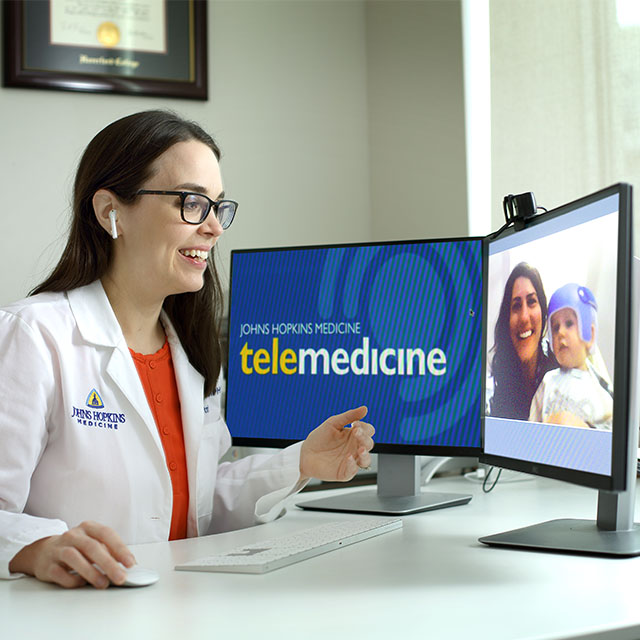Coronavirus Triggers Telemedicine Acceleration
Thanks to earlier telemedicine pilot projects, Johns Hopkins pediatricians got a jump-start in preparing to see patients virtually.

Pediatrician Helen Hughes during a video visit with a young patient and mom.
As a pediatric cardiologist as well as chief informatics officer for Johns Hopkins Children’s Center, Philip Spevak quickly realized he’d be changing the way he practiced medicine when the coronavirus hit Maryland.
“My life as a pediatric cardiologist changed dramatically: I used to carry a stethoscope, but now I’d have to learn how to be a specialist without the traditional tools,” says Spevak. “I’ve always been a fan of telemedicine. Now, because we don’t have the ability to manage our volume of patients face to face, I’m an even bigger fan.”
The Children’s Center’s preparations for the virus and the disease it causes, COVID-19, were unwittingly sparked by pediatrician Helen Hughes and her early work in telemedicine outreach for pediatric subspecialists. In 2018, she spearheaded development of a telemedicine collaboration with the Talbot County Health Department on Maryland’s Eastern Shore. The goal was to ease the burden of long treks to Johns Hopkins’ Baltimore campus for young patients — especially medically complex patients — for follow-up visits. At the time, she said, “This is where the future of health care is headed. Video technologies can allow us to do so many things for our patients without having to see them in person every time.”
With COVID-19, the future is now, Hughes realized when asked to lead the Children’s Center telemedicine program again in early March and rapidly expand it in response to the virus and state stay-at-home orders. Parlaying what she learned through her Eastern Shore telemedicine experience and others that followed, Hughes worked with the Johns Hopkins Office of Telemedicine to rapidly ramp up the program for all patients.
“We had to convert much of what we did in ambulatory medicine to telemedicine,” says Hughes, who sees patients in the Johns Hopkins Harriet Lane Clinic.
To do so, however, presented significant obstacles. The Office of Telemedicine was hugely helpful in technological assistance and operationalizing telemedicine visits, says Hughes, but there were legal and insurance issues to tackle as well. During the Eastern Shore pilot, for example, Maryland Medicaid rules stipulated that patients would only be covered if they were seen in a health care facility, which is why they were seen in a Talbot County Health Department clinic. COVID-19, Hughes says, changed all that.
“When it became clear to everyone that the coronavirus was going to turn into the pandemic that it turned into, a lot of the federal and state rules changed in the course of days,” she says. “Now patients have coverage and we can bill for video visits with patients in their homes, where we couldn’t often do that before.”
Some cross-state licensure requirements were waived, as well, Hughes adds, so patients could maintain continuity of care across state lines.
Signing patients up for user-friendly platforms approved to conduct telemedicine applications, especially video visits, was another hurdle. Johns Hopkins’ preference is its electronic medical record for patients, called MyChart. Last May, however, only 45% of the patients seen in clinic that month were registered on MyChart. Spevak intervened to make it easier for patient access.
“Phil Spevak worked very hard to streamline MyChart registration, which involved forms for parents to sign for proxy access to the child’s chart, which was a barrier,” says Hughes. “They now use a formless enrollment process where we enroll the patient and parent together on MyChart by phone, without the need for signing a form in person.”
The results of these efforts? The Children’s Center, notes Hughes, had been conducting between zero and eight video visits per month for the past two years. In the second half of March, after the coronavirus had clearly arrived, Johns Hopkins pediatricians and pediatric subspecialists saw 800 patients via telemedicine. That number increased to 1,400 telemedicine visits in the first half of April. Additionally, MyChart users in April jumped to 71%.
“A lot of our pediatric divisions are now seeing 80% or more of their patients by video or telephone,” says Hughes.
Much of the credit goes to Johns Hopkins Office of Telemedicine — its training videos and tip sheets — and pediatricians who have taken on the role of telemedicine physician champion in each division of the Department of Pediatrics, says Hughes. There are still technical speed bumps to contend with, she adds, but frustrations have been mitigated by the positive response by patients and their pediatricians.
“Providers are very enthusiastic to have the opportunity to provide care for their patients and preserve their long-term relationships, which you want to continue,” says Hughes.
Spevak agrees: “I now realize even more the simple act of having a video visit with the patient and parents can have so much value.”
Will telemedicine and its added value be a greater part of practice after COVID-19 has subsided and stay-at-home restrictions have lifted? If Maggie Moon, chief medical officer of the Department of Pediatrics, has her way, the answer is yes.
“In going forward, we will continue to use telemedicine if the government continues to support it because it is so much in the interest of our families,” says Moon. “We haven’t hit our stride completely, but Helen Hughes has done a brilliant job of coordinating, teaching and encouraging faculty to adopt this practice. This has really been cool work.”